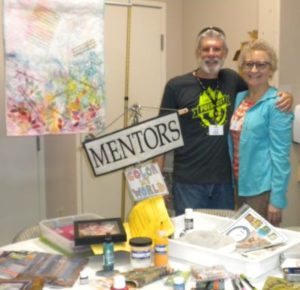
Here is the information requested by several of you. I included in this email links to several sites for information.
Depending on the product(s) you are using, make sure to protect your work surfaces. I usually use a large clear plastic/vinyl painting tarp. They are large, fairly inexpensive and you can cut them down for different work areas so you have a choice of what works best for your project.
Check out Pinterest and YouTube for ideas and tutorials on all the materials. Instagram also has some people posting work and information.
SetaColor for sun printing and painting:
There are several places to purchase on line. Check the local stores first (Joanns, Michaels, Hobby Lobby or the local art store).
The colors are thinned down to start (2 parts water, 1 part paint), so even starting with the small bottles will be enough to experiment with. They can be thinned down more, but 2:1 is the starting mixture. Inexpensive spray bottles can be used or paint brushes, depending on the look you want. Have a large selection of flat items (leaves, old jewelry, gears, etc) to place on your fabric as soon as you have the color applied. Working on a foam core board or cardboard so you can pin the corners down is a good idea so your fabric doesn’t end up in the neighbors yard.
Dick Blick is an on line art store that also sells them and has a physical store in Tempe. https://www.dickblick.com/stores/arizona/tempe/
Derwent Inktense Pencils:
Can be used and flow more softly like watercolor if activated with water (I normally use water brushes but small spray bottles can be used for a different look. The more water used the more fluid the reaction will be) or have more control using other mediums. Good idea to do color swatches (and label them) with water and your other medium choices to see how they react and the color intensity on your fabric. I have my main color chart on white fabric. I then do a test of a few colors on the fabric I am going to use for a project to see the color intensity changes so I can make adjustments for any variables.
Whereas man-made fibers do not absorb the color, the color sits on top of the fiber and can be much less colorfast. Derwent Inktense pencils work very well on 100% cotton fabrics, including cotton canvas. … Derwent Inktense pencils, indeed, have ink in the lead and will be permanent once dry.
Jacquard deColourant/deColourant Plus:
There are two types, basic deColourant that just removes color from your fabric, and deColourant Plus that adds a color back in. Plus Colors can be mixed and blended to create other colors, so a few primary basics will give you a wide range to choose from.
Various Paints:
Poke around the Jacquard Products website. Lots in information and inspiration.
Paper Collage on fabric:
I used thinned acrylic medium to adhere my paper (tissue, or other speciality papers can be used as well as small epherma) to my lightweight muslin base. Netting of various size and colors can be placed over the final surface to really secure the pieces to the final surface. Ribbons, yarns and other interesting pieces and bits can be added for extra texture. I prefer using Golden Products for my medium to ‘glue’ down my paper, etc, but there are a lot of other brands on the market to choose from
I use a trash bag (I prefer white but I have also used the large black garden trash bags) or other plastic surface to protect my work surface.
Alcohol Inks (Includes alcohol markers like Sharpies, etc):
I have ‘mono-printed’ on white ultra suede or other fabrics by coloring or spreading inks onto a white trash bag or glass. I then spray rubbing alcohol over the surface and let it blend or encourage it a bit with blowing it with a straw or dragging a tool (chopstick, fork, palette knife or other instrument that won’t soak up the ink). I sometimes will pick up a corner of the bag to move the inks around more.
If a larger piece of fabric for the monoprint, have someone help you place the fabric on top of the inks. Let them soak in a bit before lifting back off. You can also move the fabric around on the bag by pinching and pleating to add more interest and texture. It is always good to experiment with a small piece first when playing with color blends and textures. Getting a perfect repeat is impossible but it will give you a basic idea of what your blend and texture will look like.
Alcohol inks can also be used on metal and other slick surfaces (disposable baking tins, yogurt aluminium covers, inside of toothpaste tubes, etc) They will take longer to dry and will need to be sealed with a clear coat after. I would not wash a quilt that had these attached. All these products can be sewn through but do not use a thin thread as the sharp edges of some of the products (baking tin for example) can cut the thread.
I always look for new materials to try and experiment with. There is lots of printing, stenciling and painting ideas that work well with fabric.
Have fun playing.
Patricia and David Charity

